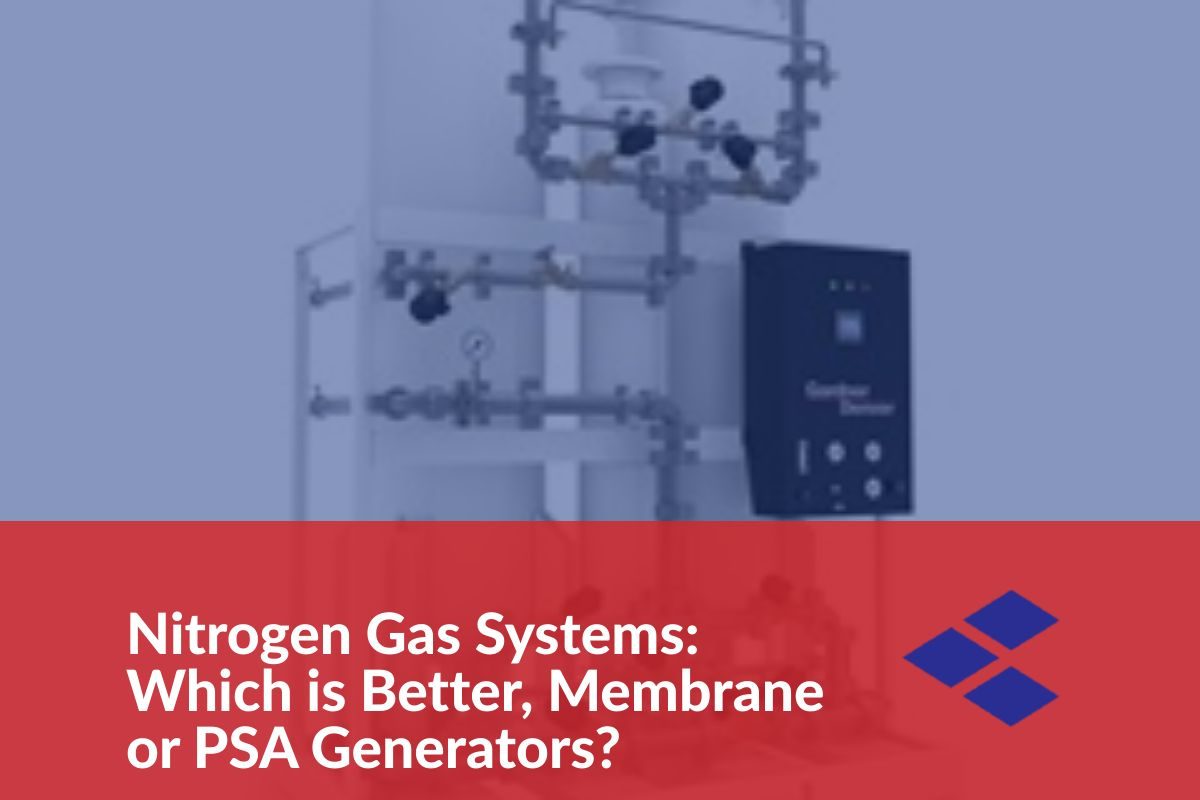
Selecting the correct type of nitrogen generator for your application’s needs is complex. When researching the best types of nitrogen generators on the market today, you will undoubtedly come across both Membrane and PSA generators. Determining which generator type is best for your system depends on how each type of generator’s qualities best meet your application’s requirements.
How Do Membrane Nitrogen Generators Work?
Membrane nitrogen generators work by utilizing selective permeation. Semi-permeable membranes within the generator allow only specific molecules to pass through.
During the operation of a membrane nitrogen generator, air passes over a hollow fiber membrane. Throughout this process, impurities and smaller molecules, like oxygen molecules, are filtered out by the membrane. After being filtered out, these materials exit the generator as waste in the form of a gas known as permeate. The nitrogen-rich gas allowed to pass through the membrane is then collected and stored until needed.
How Do PSA Nitrogen Generators Work?
The adsorption principle allows PSA nitrogen generators to operate, separating nitrogen from other gasses like oxygen. Most PSA nitrogen generator systems are made up of two adsorption beds, each containing carbon molecular sieves. Carbon molecular sieves allow nitrogen to pass through while absorbing impurities, water, and oxygen.
During the operation of a PSA nitrogen generator, the air is passed through one adsorption bed, which removes the oxygen and other impurities, containing them within the carbon molecular sieve. The nitrogen gas that passes through the sieve is collected and stored until needed. Once the adsorption bed reaches the limit of oxygen and impurities that it can contain, it is purged utilizing nitrogen-rich gas from the other adsorption bed. The two beds are continuously alternating, absorbing impurities and being purged.
A Comparison: Membrane vs. PSA Nitrogen Generators
Now that it is clear how each type of nitrogen generator works, there are some essential differences between the two to be mindful of when choosing a generator for your application.
PSA nitrogen generators have more moving parts than membrane generators, making them larger and heavier. The size and weight of these generators result in higher installation costs and space requirements in the warehouse or manufacturing facility. These generators can achieve higher nitrogen purity levels and are slightly more cost-efficient than membrane generators. However, in areas of high humidity, membrane generators may be a better option, as PSA generators are more sensitive to the presence of water. PSA nitrogen generators are also known for having a longer lifespan than their membrane counterparts. PSA generators can run efficiently for decades with proper maintenance and contamination avoidance.
Membrane generators are more appropriate for applications within smaller spaces, as they lack many moving parts that come with PSA generators, making them ideal for applications requiring a mobile nitrogen source. While the purity of nitrogen produced by membrane generators is lower than that of PSA generators, purity levels are still high, ranging from 95% to 99%. Membrane generators are also nearly as highly efficient as PSA generators at purity levels up to 98%. Higher water tolerance (to a degree) is another benefit of membrane generators compared to PSA generators, though neither generator type is tolerant of prolonged exposure to water contamination. With proper maintenance and filter replacement, membrane generators can be used reliably for up to 10 years.
Understanding Your System’s Needs
The best way to make an informed decision about the correct type of nitrogen generator for your application is to understand your system’s needs. Keeping in mind the level of nitrogen purity your production needs, PSA generators can achieve the highest level of nitrogen purity. If your facility is limited in space or requires mobile nitrogen use, consider opting for a membrane generator, which is more space-conscious and easier to move. If the lifespan of your generator is the most critical factor in your decision, a PSA generator may be your best bet. On the other hand, if potential humidity is an issue, membrane generators are more capable of handling water contamination.
ESA for Your Nitrogen Generator Needs
Regardless of the type of nitrogen generator ideal for your application, the professionals at ESA are here to help. With decades of experience in nitrogen generator installation and repair, our trained technicians can help no matter your needs.
The pros at ESA are available 24 hours a day, seven days a week, to answer any of your questions and address any concerns you have with your existing generator. If this is your first time purchasing a nitrogen generator, call us for a consultation and assistance in selecting the right system for your requirements.
Arthur Pue
Arthur Pue is the President of Engineering Sales Associates. Connect with him on LinkedIn.
